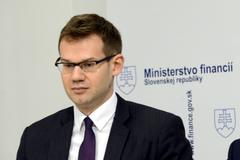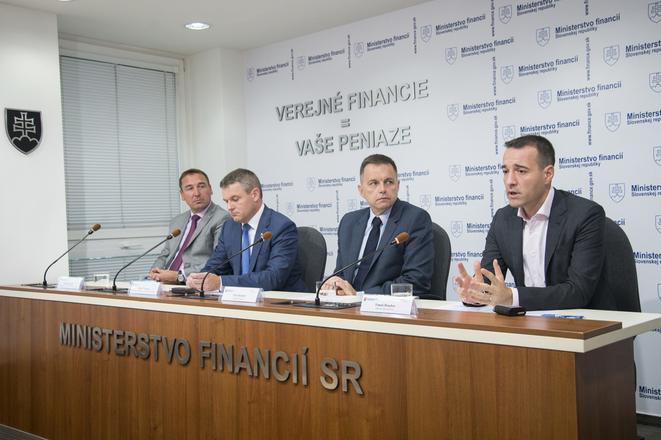As promised in its programme statement the government has launched examination of expenditures of three significant arears. Based on the Best of All Possible Worlds – Value for Money in Slovak Public Policies initiative put forth by the deceased economist Martin Filko analysts have started revising expenditures in transport, health care and information technology.
“We’re not reinventing a wheel that should be a complete novelty in the world,” said Finance Minister Peter Kažimír. “We only want to use the best practice from around the world and from Europe in order to spend taxpayers’ money in a better way.”
The aim of the government is to reform rules and processes and make them more efficient in order to facilitate meaningful and good decisions, according to Kažimír. Decisions on key investments should be based on analysts’ opinions and documents.
“We’re ready to be publicly confronted with opposite opinions of analysts,” said Kažimír, adding that even after public confrontation, the government has the right to decide otherwise.
Analysts from the Institute of Financial Policy (IFP), a government think tank at the Finance Ministry, and other organisations focus on three sectors identified as the biggest spenders and those with biggest problems: health care, transport and the cross-sectoral process of informatising society. These sectors make up almost 40 percent of public administration expenditures. The result should be more effective spending of expenditures of about 0.5 percent of the gross domestic product or €400 million annually.
Kažimír stressed that this means that people should not expect savings but rather a better utilisation of money and thus more value for that money.
On July 26 the analysts made their interim reports public. In them they arrived with some preliminary results and identified targets of the revisions in the form of measurable indicators.
The analysts will complete the final reports by autumn, while the cabinet wants to use their findings and proposed measures when preparing state budget for the next three years.
The plan is to examine expenditures also in other sectors and make such examination a standard annual procedure.
So far analysts have found a shortage of data with much of it of low quality or non-existent. Thus another aim of the Value for Money project is to make an order in data and set frameworks for collecting it.
Value for Money
The Best of All Possible Worlds – Value for Money in Slovak Public Policies is an initiative economist Martin Filko introduced just after the March general elections and a few days before he died in a drowning accident. Its main message is that government decisions should be based on analyses which lead to an effective and performance-oriented public administration. Elements of the initiative on which Filko worked together with Štefan Kišš and Ľudovít Ódor have made it to the programme statement.

Health care
In the health-care sector analysts have found that even though Slovakia spends more money on healthcare that neighbouring countries, the results lag.
The aim of the revision of expenditures in this sector accounting for 5.3 percent of GDP annually is to improve fiscal sustainability and effectiveness of expenditures while the growth of expenditures should slow down to inflation. The index, by which analysts want to measure achieved improvement, is avoidable mortality.
“The aim of the revision is to decrease by 2020 the number of deaths avoidable by health care to the level of the Czech Republic, Poland and Hungary, which means by 15 percent,” the preliminary report reads.
To achieve this Health Minister Tomáš Drucker wants to focus on five areas: the efficiency of hospitals, consumption of drugs, laboratory examinations and therapies, emergency medical service and health insurance companies.
“In order to be able to ensure health care for the widest possible population ... we must address the issue of standards or scope of how much money we have and in what way we will redistribute it,” said Drucker. “It’s not about saving money, it’s about increasing efficiency.”
Transport
In the sector of transport the analysts were not able so far to arrive with a single indicator by which to measure the achieved improvement.
“But fulfilment of the goal can be monitored via mostly output indicators like traffic congestions, the time necessary for traveling between economic centres, the accident rate, the number of people using public transport and environmental impacts,” the interim report reads.
The revision of expenditures in transport accounting for 2.3 percent of GDP annually should bring measures to keep the current package of investments but make it more effective as well as to make individual operational expenditures more effective in a sustainable way.
Informatisation
Analysed expenditures in informatisation account for 0.6 percent of GDP while the analysts indicate a need of better data of costs and results. They also identified some bottlenecks preventing wider usage of state electronic services.
“Non-active electronic IDs as well as requirements for guaranteed signature brake down contributions and benefits to be brought by new digital services,” the analysts list among their so-far findings.
The target should be to achieve operation comparable with the commercial sector.
To improve data to monitor the next development in informatisation, the Finance Ministry is introducing new classification, according to which all IT expenses will have their own code and will be clearly identifiable in the future.
As a result of joining the Value for Money project, Pellegrini is expecting greater transparency and efficiency in IT.
“On the one hand, to try to reduce costs, where possible, especially for operation and maintenance services; on the other hand, also get more value for the same money,” he said.
Shortcomings
Most economic analysts and experts welcome examination of expenditures in the first three areas while they see some shortcomings in the approach of the Value for Money project.
“Already the interim reports pointed out via some numbers on numerous ineffectivities in expenditures of the public administration,” Martin Vlachynský, analyst of the Institute for Economic and Social Studies (INESS) think tank, told the news channel TA3, adding that the analysts have already indicated directions for possible solutions. “But what is the biggest problem of this approach is that the Value for Money project does not address motivations to act effectively.”
Vlachynský thinks that it may provide data, and some instruments for achievement of a higher effectiveness, “but it will be on the political process and decision of politicians who actually control those buttons with public expenditures whether they will follow them”.
Out of three so-far examined sectors Vlachynský sees the healthcare as the most sensitive politically while he points out that analysts have come out with findings that have been indicated for several years. This is, for example to decide which medical treatments and performances should be covered from the compulsory health insurance and which should be deemed as upper-standard or that in the past fees for appointments with doctors were effective in reduction of such appointments.
“This means that solutions already exist here, but they were so far politically extremely costly,” said Vlachynský. “It will be very interesting to see whether some of the proposed measures would reflect in real policies.”
In terms of examining expenditures in informatisation, so-far results have shown the problem with data as this is a cross-sectoral process and that the examination may give a broader picture and indicate which solutions are more advantageous, according to Vlachynský.
Within the transport sector he sees a problem in not completely clearly drawn goals.
“We know today which railways are extremely ineffective, which highways are more or less advantageous in terms of finances, but because all these pursue some public purpose, there have not been listed in the report almost no proposed solutions,” said Vlachynský.



 Ministers Roman Brecely, Peter Pellegrini, Peter Kažimír, Tomáš Drucker, from left (source: TASR)
Ministers Roman Brecely, Peter Pellegrini, Peter Kažimír, Tomáš Drucker, from left (source: TASR)